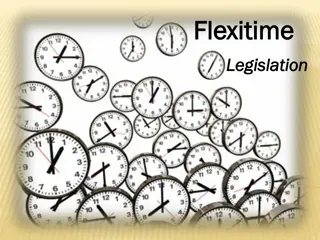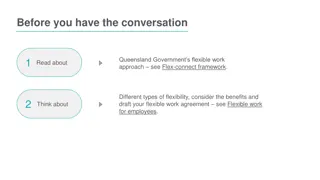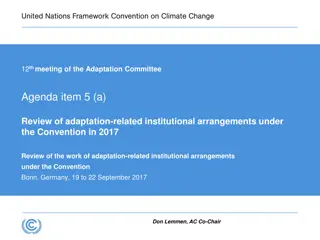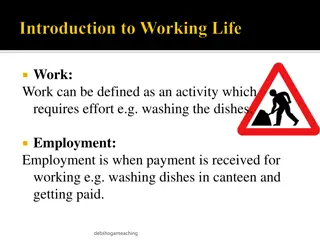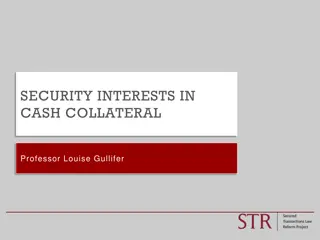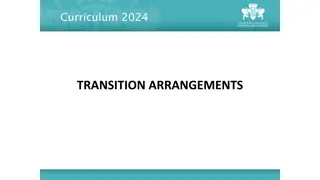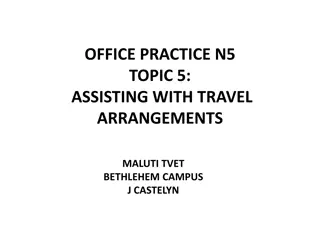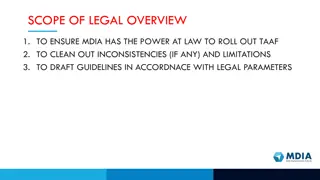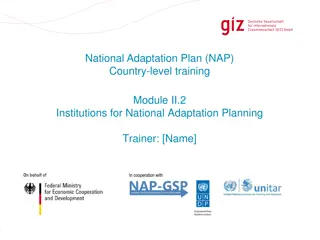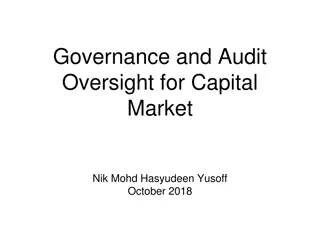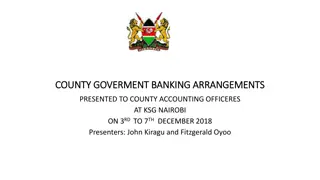Understanding Flexible Work Arrangements
Explore various forms of flexible work arrangements including full-time, part-time, job sharing, and compressed scheduling. Learn about the benefits and disadvantages for both employers and employees. Discover how these arrangements provide options for a better work-life balance and increased job flexibility.
Download Presentation

Please find below an Image/Link to download the presentation.
The content on the website is provided AS IS for your information and personal use only. It may not be sold, licensed, or shared on other websites without obtaining consent from the author. Download presentation by click this link. If you encounter any issues during the download, it is possible that the publisher has removed the file from their server.
E N D
Presentation Transcript
FLEXIBLE TIME FLEXIBLE TIME
THE VARIOUS FORMS OF THE VARIOUS FORMS OF FLEXIBLE ARRANGEMENTS FLEXIBLE ARRANGEMENTS
What is full timing full timing? - Around 35 to 40-hour work week altogether - Concerns more than of offices Main Advantages : for employees : full time salary and benefits guaranteed , offers safety and more professional career opportunities. for employers : fixed schedules are easier to plane
What is part timing ? Part-time workers work fewer hours (15 to 30 per week) than full time workers. Main Advantages : Fewer hours at work mean more time with family and better work life balance, lighter workload Main Disadvantages : Employees want to do more in less time, they are stressed. Lower income. Fewer career opportunities.
job sharing Job sharing is a work arrangement in which two people work part-time and share the responsibilities of one full-time job. Main Advantages : For employers : Possibility to retain talented workers who want flexible working arrangements, two skilled workers instead of one For employees : Less stress, more motivation Main disadvantages : For employers : can be more costly, not productive if both employees are not able to collaborate. For employees : Can lead to failure and stress if both employees can t work in collaboration.
Compressed scheduling It offers employees the opportunity to work the equivalent of a standard workweek in fewer than the usual number of days. (Working 4 days instead of 5 for example) Main Advantages : Employees can enjoy one full day off work, save on petrol Main disadvantages : Employees work more hours the rest of the week, it can be tiring and stressful.
What is flextiming ? Flexitime is an arrangement where an organisation gives its employees the opportunity of a flexible working hours arrangement and flexible locations. Staff can choose when they work, on condition that they achieve their total daily, weekly or monthly hours. Main Advantages : More time with family, full-time salary as long as the task is completed, less stress because of fixed working hours. Main disadvantages : Less focus on work, likely to affect efficiency
Working Working from from home home ADVANTAGES ADVANTAGES FROM WORKING FROM HOME: FROM WORKING FROM HOME: -It s nice to stay home -Employees are close to their family and share important moments such as mealtimes -It allows employees to work autonomously and to be responsible -It is more environmentally friendly because employees don t have to commute -It offers more freedom : employees can organize their own schedules -They save costs on fuel, and spend less time in transports (are less stressed) DISADVANTAGES DISADVANTAGES FROM WORKING HOME: FROM WORKING HOME: -It is easy to get distracted by things which are going on around you. -Employees may feel lonely and need the contact distance with their colleagues -Exchange between colleagues is limited -It is sometimes difficult to find an adequate and isolated workspace -It is also difficult to set up an independent telephone line -Employees must have ADSL.
TO SUM UP Flexible time generally offers a better balance between private life and professional and better productivity at work, But Conflicts between employees are frequent because it is difficult for employers to choose what employee they will grant flexitime to. Also flexible schedules require reorganizing the working hours of all employees within the company. This can be time consuming.
Nourou Saindou Marina Fayol Kenzy Honorine Oph lie Reboul Guillaume Aboukir Johana Hoarau BTS AM1 Lyc e Antoine Roussin



